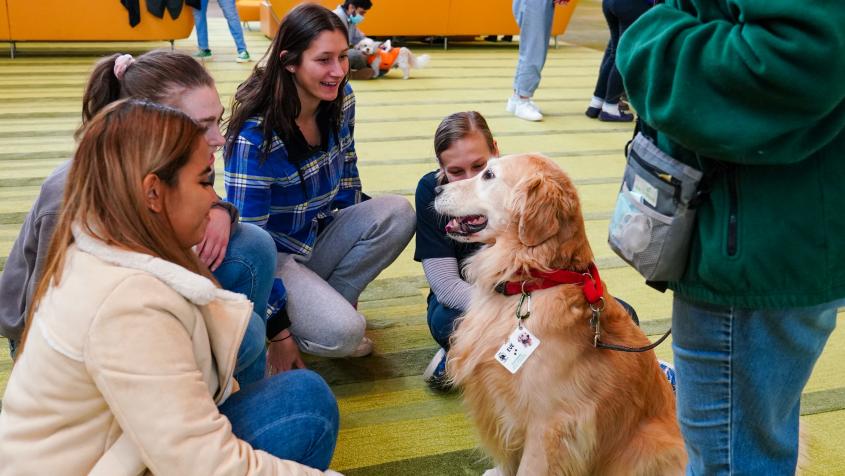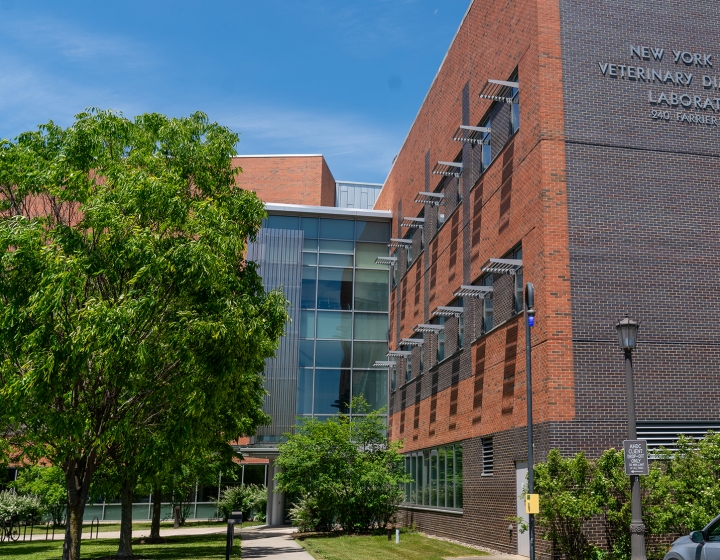Cornell Companions celebrates 25th anniversary of animal-assisted outreach
When people hear about upcoming community celebrations at the Cornell University College of Veterinary Medicine (CVM), a familiar question is often afloat: “Will the puppies be there?”
No, folks aren’t asking if patients from the animal hospital will be wandering through — but rather about the Cornell Companions, a volunteer-run, animal-assisted therapy program that brings animals to community spaces such as schools, nursing homes, libraries and more. Founded at CVM, the program has grown into a beloved institution at the college, Cornell and the local community. This year, the program celebrates its 25th anniversary.
“The humans and the animals are incredibly dedicated to animal assisted activities and therapy,” says program director Janet Gray, who has been involved with the group since 2000. “We have seen the remarkable impact on those we visit, from those in skilled nursing to hospice to children with special needs to students under stress.”
Formally administered out of CVM, the program now boasts 25 active volunteers who handle dogs, cats, an owl, a goose – and even a llama — and regularly visit 10 facilities, plus many special visits to college departments across Ithaca College and Cornell University.
The start of something special
It all began with Jennifer Matlow, D.V.M. ’00, who, along with her boyfriend at the time, wanted to spread the love they received from their own animals. “The goal was to share the love,” she says. “I remember thinking, ‘other people should get to spend time with these dogs besides us.’”
She recruited a few fellow veterinary students and sought a faculty member to advise the group. That would be Jane Shaw, D.V.M. ’90, who was academically interested in human-animal interactions. “I was super interested in the human-animal bond,” says Shaw, “I started researching what people and programs were being done in this area.” She found inspiration from organizations like Green Chimneys, where animal-assisted therapy is central to their educational programs.
“We had the thought of, ‘Wow, what if we could bring our dogs in to schools and work with kids that are struggling,’” Shaw says. “We thought our dogs could be motivators to help kids learn to move, to speak, to be gentle. We could make their exercises a little more fun because they would have this canine companion with them.”
As faculty advisor, Shaw developed the partnerships with area schools, overseeing scheduling and developing the screening program for participating dogs and humans.
Those founding volunteers were first made up of veterinary students, but soon staff and community members discovered the group, including former Animal Health Diagnostic Center employees Ruth Shannon, Ann Manzano and Marg Pough, who were later joined by Steve Hall and Jean Snow, among many others.
In the early days, the group began making visits to two community facilities: Racker, a non-profit institution in the region that provides services for individuals with disabilities, and the Boards of Cooperative Educational Services (BOCES) of New York State, an education facility.
Leslie Appel ’90, D.V.M. ’94, joined the program with her Doberman, Zeppy, and her mixed-breed BeeBee, and would later become director of the program after Shaw left. Appel expanded the range of facilities the companions visited into local nursing homes, the Cayuga Medical Center and incarcerated youth centers like the Louis Gossett Facility and Lansing Residential Facility. “Animals make natural and meaningful connections with people at all stages and situations in life,” says Appel.
Appel also expanded the types of animals that were part of the program beyond dogs, including cats, llamas, a camel, rabbits, birds and reptiles. “Different people relate to different animal species,” she says.
As the program continued to grow in scope and impact, generous donors soon lent their support — including Abby Smith and Tom and Peggy Weissenborn — further helping to build resources and capacity.

Training to be a Cornell Companion
At the very outset, training the animals was a cornerstone of the program. Shaw’s research and interest into animal-assisted activities was vital in ensuring that each animal would be a safe and enthusiastic participant. “Safety was of the utmost importance,” says Shaw.
Trainings took place in the livestock arena belonging to the College of Agriculture and Life Sciences. There, animals navigated a course with unusual or startling items— an opening umbrella, a wheelchair, a crowd of people touching the fur, banging pots and pans.
Student founder Matlow recalls running through these trainings with her and other animals. “We learned that it’s not a problem if the dog startles,” she says. “What you’re really looking for is how quickly they recover.”
She also discovered through bringing her own dog to community visits that the animal should have a natural love of attention. “Just because a dog is nice doesn’t mean they’re going to be a good therapy dog,” says Matlow. “My beautiful dog Samantha didn’t really seem to enjoy it. She never did anything wrong, but I could tell that all those hands petting her seemed to stress her out.”
Shaw’s dog, on the other hand, was born for the work. “Jake was my angel dog,” says Shaw. “He was just the sweetest, the calmest, the most beautiful demeanor. He just knew what to do.”
Intuiting what people need and loving human attention is a key quality of a Cornell Companion. Longtime-member Shannon recalls how they screened each animal to ensure that they could interact happily with all types of people — the very young, the very old and those who are ailing or neurodiverse. “You can’t push your agenda on your dog,” Shannon says.
As a result, the animal participants are all-in on their duties. “As soon as I put on my Cornell Companion’s t-shirt, my dogs will run to the door,” says Jean Snow, a member since 2004.
Today, the Cornell Companions train through socialization, manners and basic obedience skills found in the AKC’s Canine Good Citizen test and Canine Good Citizen Community. “We are looking to partner with the Ithaca Dog Training Club to offer a training course in the spring,” says current director Gray. “But in the meantime, it is strongly advised that dogs have successfully completed a beginner I- or II-level obedience class before considering having their dog take the assessment.”
For dogs, an AKC evaluator from the Ithaca Dog Training Club assesses the animal’s basic training skills, such as walking on a loose leash and obeying “sit,” “down,” “stay” and “come” commands. Dogs should be able to also walk through a loud crowd, handle a food distraction and get along well with other dogs and humans. Other animals such as cats, rabbits and pocket pets should be calm, well-socialized and get along well with people and other animals.
Animals aren’t the only ones that need training. In the past, the group has invited experts on animal-assisted therapy and social work for talks, and all volunteers must learn the program’s guidelines and expectations. “Humans need to take our handler training session, which goes over the history of animal assisted activities and therapy, mission statement and goals, rules and regulations, terminology and things to know when visiting,” Gray says.

Community impact
A through line over the years for the program has been its impact in the community. As a life-long animal lover, Shannon was excited to join along with her border collie Stella, “the perfect Cornell Companion.” Shannon became team leader for visits to the Francisca Racker Center. “We had such a committed group of volunteers — I especially liked working with the children,” says Shannon. “The visits were like mindfulness sessions. You were with this child and your dog, and you concentrate on only that. It was just so rewarding.”
She recounts a meaningful moment at the Racker Center childcare program, where one little boy, who seemed to be mostly non-verbal, had been running around in restless circles. “I said to him, ‘Do you want to shake my dog’s hand?’ and he came over to Stella and said, ‘Hello doggy, how are you?’ and sat there with her for many minutes.”
One child who required physical therapy for motor skills was allowed to have Pough’s border terrier, Robin, join in on the session, which helped motivate the little girl to do her exercises. Longtime-member Manzano recalls how the presence of her dogs helped some wheelchair-bound children to relax tightly clenched hands to pet the visiting animals.
Other children that started out being afraid of dogs would inch closer each week Shannon and Stella would visit. Eventually, they’d be petting and snuggling the animal. “There’s just something about animals,” Shannon says.
“I find it incredibly rewarding to see the impact the dog has on a child, to see the impact it can have over the year with the child’s progress, it’s really emotional,” says Snow.
Pough’s border terriers became so beloved that the children’s classrooms made sure to celebrate their birthdays each year, complete with treats and party hats. And, in further testament to the impact these animals have, the group, in conjunction with the Racker center, was awarded the New York State Senate’s Community Service Award in 2013.
Adults benefit just as much as children from the program. Gray recalls visiting the MacCormick Secure Center. “I interacted with young men who had never interacted with a dog before and got to see them pet and hug my dog for the first time,” she says. She also treasures visiting an outpatient program for stroke and brain injury patients at Ithaca’s Longview Senior Living Community and seeing the impact the companions had on people’s rehabilitation.
Appel particularly loved bringing her dogs to nursing homes. “I loved sharing my beloved dogs especially with the residents of nursing homes, many of whom missed their own dogs. I loved seeing the true joy and comfort the elderly residents experienced just by getting a visit from my dogs,” she says.

A quarter-decade of commitment, and counting
With 25 years of dedicated community service behind them, the Cornell Companions has a lot to be proud of, and a lot to look forward to — as the volunteers show no signs of winding down. “The program makes me feel good,” says Pough. “I want to continue to do it as long as I can.”
Director Gray agrees. “I enjoy being able to do something with my dogs to help people,” she says. “I love the relationships I build with the people we visit.”
Current volunteer Hall agrees. “For me, it’s just watching the joy in other people’s eyes,” he says. “It’s nice to be able to share the love that pets bring to people.”
As former faculty founder, Shaw eventually went on to pursue a pioneering career in animal-human interactions at Colorado State University. She says the program significantly shaped her career. “It was instrumental,” she says. “What we were doing in the Cornell Companions has come full circle with my work in the human-animal bond, and how we honor that as veterinarians. Knowing that the groups is still going strong after all these years, with many of the same volunteers who started out in the very beginning—it brings tears to my eyes.”
Written by Lauren Cahoon Roberts






